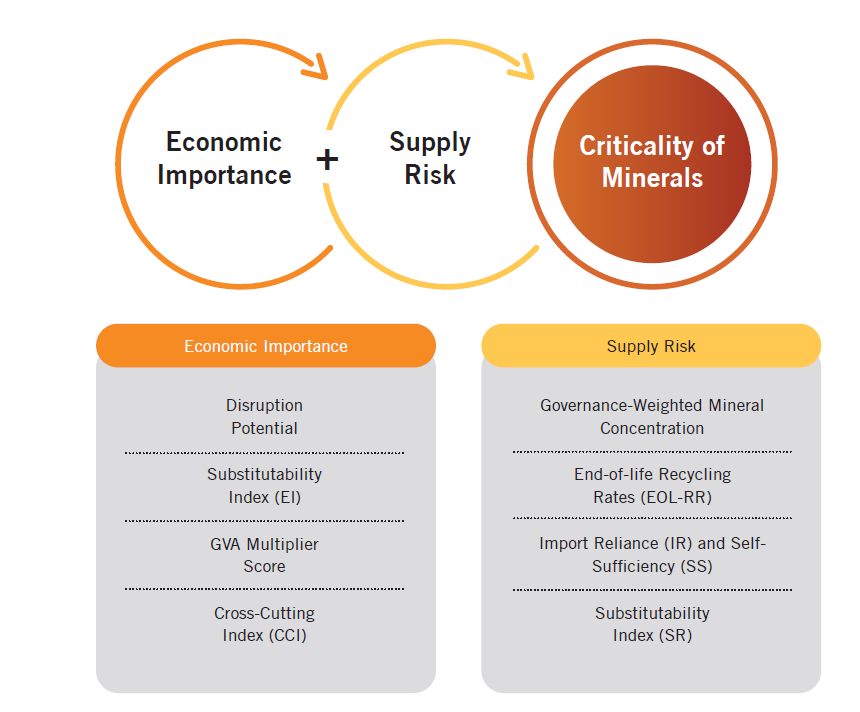Geography
Surge in Demand of Copper
- 08 Mar 2024
- 6 min read
For Prelims: Properties and Applications of Copper, Mining Methods of Copper, Copper Deposits in India, Hindustan Copper Limited, Chalcopyrite, Bornite, Chalcocite
For Mains: India’s Copper Appetite, Copper as an Economic Barometer.
Why in News?
As demand for copper grew by 16% yearly-on-year in FY23, policymakers and corporations have increasingly turned their attention to the critical role of copper in spurring economic growth.
What are the Key Points Related to Copper?
- About: Copper is a malleable, ductile metal known for its excellent heat and electricity conductivity. It possesses corrosion resistance and antimicrobial properties.
- Malleability refers to the ability of a material to be pressed, or rolled into thin sheets without breaking or cracking.
- Ductility is the property of a material that allows it to be stretched or drawn out into a thin wire without losing its strength or breaking.
- Applications: It is widely utilised in construction, consumer durables, transportation, and industrial manufacturing.
- It is also Integral to clean energy technologies such as solar panels, electric vehicles (EVs), and energy-efficient motors.
- It is a 100% recyclable metal (allows for a circular economy).
- Occurrence and Composition: It is naturally found in various forms in the Earth’s crust.
- It can be found in sulphide deposits (as chalcopyrite, bornite, chalcocite, covellite), in carbonate deposits (as azurite and malachite), in silicate deposits (as chrysycolla and dioptase) and as pure native copper.
- Most commercial copper ore deposits contain an average grade of 0.8% copper, while copper ore in India has an average copper content of around 1%.
- Mining Methods: There are two primary methods of copper mining: open-pit and underground mining.
- Open-pit mining dominates, constituting 80% of global copper mining operations.
- Copper Deposits in India: Mainly located in Singhbhum (Jharkhand), Balaghat (Madhya Pradesh), and Jhunjhunu and Alwar (Rajasthan) districts.
- Minor deposits are found in Agnigundala (Andhra Pradesh), Chitradurg and Hasan (Karnataka), and South Arcot (Tamil Nadu) districts.
- India’s Copper Appetite: India's demand for copper is soaring due to rising infrastructure projects, renewable energy initiatives, and urbanisation.
- Despite this, the country heavily relies on copper imports due to limited domestic reserves.
- To address this, the government is promoting investments in smelters and refineries while Indian companies are acquiring copper mines abroad to secure a stable supply and reduce dependence on international markets.
- Recently, the Ministry of Mines has proposed sending an Indian industry delegation to copper-rich Zambia to discuss potential copper exploration and mining projects in the southern African country
- Recognizing copper's criticality, the government has included it in its list of critical minerals, highlighting the need to reduce import dependence.
- Hindustan Copper Limited (HCL): Established in 1967 under the Companies Act, It is a Miniratna Category-I enterprise operating under the Ministry of Mines, Government of India.
- It was formed to consolidate all copper exploration and exploitation projects from the National Mineral Development Corporation Ltd.
- HCL is India's only vertically integrated copper producing company.
- Copper's Key Importance:
- Copper as an Economic Barometer: Copper prices reflect demand/supply dynamics, monetary markets, and speculation, making it a global economic indicator.
- Unlike sector-specific commodities, copper is integral across all economic sectors.
- Copper for Energy Efficiency: Copper plays a vital role in promoting energy efficiency in buildings.
- Its excellent thermal and electrical conductivity make it ideal for wiring, heat exchangers, and roofing, leading to reduced energy consumption for heating, cooling, and lighting.
- By minimising energy losses throughout a building's lifespan, copper contributes to a more sustainable future.
- Copper as an Economic Barometer: Copper prices reflect demand/supply dynamics, monetary markets, and speculation, making it a global economic indicator.
Note
- Chile is the top copper producer in the world, with 27% of global copper production. In addition, the country is home to the two largest mines in the world, Escondido and Collahuasi.
UPSC Civil Services Examination Previous Year Question (PYQ)
Prelims
Q. With reference to the mineral resources of India, consider the following pairs: (2010)
Mineral : 90% Natural sources in
- Copper : Jharkhand
- Nickel : Orissa
- Tungsten : Kerala
Which of the pairs given above is/are correctly matched?
(a) 1 and 2 only
(b) 2 only
(c) 1 and 3 only
(d) 1, 2 and 3
Ans: (b)
Mains
Q. Despite India being one of the countries of Gondwanaland, its mining industry contributes much less to its Gross Domestic Product (GDP) in percentage. Discuss. (2021)






